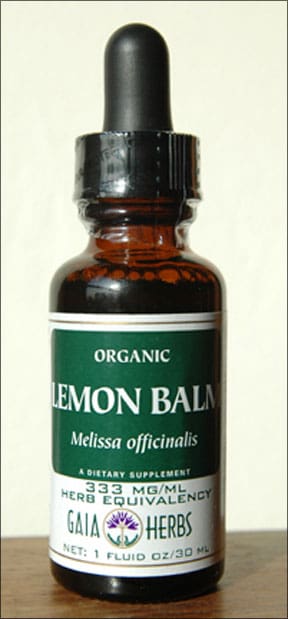[Updated August 10, 2017]
LEMON BALM FOR DOGS OVERVIEW
– Plant lemon balm in your garden, window box, or in pots.
– Add fresh lemon balm to your dog’s food.
– Add lemon balm tea to food and drinking water, and use it as a rinse after bathing.
– Brush your dog with fresh lemon balm to help repel insects.
Next month, on May 6, the first day of National Herb Week, lemon balm (Melissa officinalis) becomes Herb of the Year for 2007. A dog-friendly plant with a distinctive lemon-mint fragrance and flavor, lemon balm is best known as a nervine, a calming herb that soothes and relaxes. It’s also a digestive aid that neutralizes gas in the stomach and intestines. Add its muscle-relaxing, deodorizing, disinfecting, and insect-repelling benefits, and you can see why lemon balm belongs in your garden, window box, or patio planter.
Native to the Middle East, lemon balm traveled through all of Europe. Charlemagne ordered his subjects to plant it, Benedictine monks put it in their monastery gardens, and Thomas Jefferson grew it at Monticello. Today the plant is grown commercially as an ingredient in cosmetics, skin care products, and furniture polish.
Lemon balm’s key constituents include volatile oils, tannins, flavonoids, terpenes, and eugenol. Its terpenes are relaxing, the tannins have antiviral effects, and eugenol calms muscle spasms, kills bacteria, and has an analgesic (pain-relieving) effect. In recent years, lemon balm has made headlines for its ability to treat cold sores and other breakouts caused by the herpes simplex virus and as a treatment for Alzheimer’s Disease.
Its strong performance in the Alzheimer’s studies and its safety make it a compelling candidate for a trial with senior dogs suffering from cognitive dysfunction, or to reduce the depression and agitation that dogs with cognitive dysfunction can display.

People whose dogs’ flatulence drives them out of the room may especially appreciate lemon balm’s ability to reduce their dog’s gas.
Long considered a “universal remedy,” lemon balm is an herb that can be used for almost any ailment but is perhaps most strongly indicated in dogs with digestive problems, separation anxiety, canine sleep disorders, stress, and irritability. It is also an effective topical treatment for ringworm.
Easy to Grow
Like all members of the mint family, lemon balm has square-shaped stems and spreads more through its roots than through seeds. Under the right conditions, it grows like a weed and often is one, taking over entire gardens. Its small white blossoms are so sweet that they attract bees, hence the plant’s scientific name. Melissa is Greek for honey bee.
Lemon balm is easy to grow in full sun to partial shade. It doesn’t need fertilizer – in fact, fertilizing the plant reduces its medicinal benefits. Lemon balm is happiest in poor, sandy soil. Its seeds need several weeks of exposure to light and moisture before sprouting. Many nurseries sell lemon balm seedlings, and once plants are established, they care easily propagated by dividing the roots. Lemon balm is a thirsty plant, so water it during dry weather. However, too much rain or moisture can produce mildew, so good drainage is vital.
Unlike most herbs, lemon balm is best harvested in the afternoon, when its essential oils are strongest. For maximum yield, cut lemon balm before flowers bloom. The more it’s trimmed, the more leaves it produces.
Use Fresh Lemon Balm
Finely mince or chop lemon balm leaves and add them to your dog’s food at the rate of 1 teaspoon per 15 pounds of body weight. This is approximately 1 tablespoon for a dog weighing 45 to 50 pounds.
Fresh minced lemon balm can also be used as a poultice or wound dressing. Mash leaves or pulverize them in a blender, apply to the affected area, and hold in place with a bandage.
Lemon balm can be used straight from the garden to keep your dog smelling fresh. Simply pick a few stems, crush the leaves, and run them over your dog’s coat. In addition, lemon balm’s citronella-like fragrance is said to repel mosquitoes and other insects. If you can convince your dog to chew on a lemon balm leaf, her breath will smell wonderful.
Brew a Lemon Balm Tea
To make a medicinal-strength lemon balm tea, pour 1 cup of boiling water over 2 tablespoons coarsely chopped fresh leaves. If using dried lemon balm, the amount to use depends on the quality of the dried leaves, which usually declines during drying and storage. Most teas made from dried herbs are brewed with half the amount recommended for fresh herbs, but to produce a medicinal-strength lemon balm tea, you may need 2 tablespoons dried herb per cup of water, or even more. Don’t worry about exact measurements as this is a very forgiving and nontoxic herb. Cover the brewing tea and let stand until it cools to room temperature.
Add the tea to your dog’s food and/or drinking water, starting with small amounts while your dog becomes accustomed to the taste and fragrance. Add up to 1 tablespoon tea per 20 pounds of body weight twice or three times daily, and if treating a specific condition, such as indigestion or anxiety, double that amount. If your dog is ill or dehydrated, serve plain instead of herb-flavored water or encourage him to drink more by adding broth (instead of herbal tea) as a flavor enhancer to his water bowl.
Lemon balm tea is a disinfecting rinse for cuts and other wounds. To make the rinse even more effective, add 2 teaspoons unrefined sea salt to each cup of tea and stir to dissolve. Simply pour cold or room-temperature tea over the injury.
To use lemon balm tea as a compress, soak a wash cloth, cotton dressing, or tissue in cold tea, apply, and hold the compress in place for several minutes. To keep the area cold, soak the compress again and reapply. Cold compresses are recommended for recent or acute injuries.
To help treat chronic conditions like arthritis, hip or elbow dysplasia, or old sports injuries, use hot lemon balm tea as a fomentation or hot compress.
Lemon balm has mild muscle-relaxing and antispasmodic properties. Soak a wash cloth in comfortably hot tea, wring just enough to stop dripping, test the temperature on your inner wrist to be sure it isn’t too hot, then apply to the affected area and hold it in place for several minutes. Soak the compress again and reapply as needed to keep the area warm for 10 to 15 minutes.
After bathing your dog (except for dogs with white or very light colored coats), pour lemon balm tea all over as a final rinse.
Fill a spray bottle with lemon balm tea and use it as an air freshener.
Store leftover tea in the refrigerator. For best results, use within three or four days.
Make an Herbal Honey
Coarsely chop enough lemon balm to fill a glass jar. Next, fill the jar with honey, completely covering the chopped herb. The more lemon balm you put in the jar, the more medicinal the result. If the honey is too thick to pour easily, warm it by placing the honey jar in hot water.
Seal the jar of lemon balm and honey and leave it in a warm location, such as a sunny window, for at least two weeks. Alternatively, heat honey in a saucepan and pour it over the herbs. For a double-strength herbal honey, wait four to six weeks, then fill another glass jar with lemon balm and pour the contents of the first jar into the second jar. Before using the herbal honey, filter it through cheesecloth or a fine-mesh strainer and store at room temperature.
Consider making two lemon balm honeys, one from raw, unfiltered honey with its nutritional benefits intact and one from pasteurized, filtered honey. Use the thick raw honey for internal use and the pasteurized honey for topical application. Raw honey often crystallizes, creating sharp points that can damage burned or injured skin, unlike honey that has been heated and filtered.
When applied as a first-aid dressing, honey creates a protective barrier that seals the skin, absorbs moisture from oozing wounds, and speeds healing. Honey also releases hydrogen peroxide, which kills germs. Because honey doesn’t stick to bandages, it makes dressings easy to remove and change. Some honeys, such as manuka honey from Australia, have proven antibacterial properties, including the successful treatment of drug-resistant E. coli and staph infections. Honey infused with lemon balm can be even more potent. Lemon balm honey is an effective dressing for cuts, surgical wounds, burns, lick granulomas, abrasions, hot spots, and infected wounds. Most dogs will want to lick it off, so protect the wound with a bandage or cervical collar.
Lemon balm honey can be used to prevent infection from viruses or bacteria, soothe a sore throat, help an anxious dog relax, improve sleep, and speed recovery from illness. Added to food, lemon balm honey helps reduce gas and other symptoms of indigestion.
Use Lemon Balm in Aromatherapy
Lemon balm’s essential oil, usually labeled melissa oil, is so expensive that it’s often misrepresented. Much of what is sold as steam-distilled Melissa oil is really a blend of citronella and lemon grass. True Melissa oil costs up to $1 per drop. That’s because it takes 3 to 5 tons of fresh lemon balm to produce a single pound of essential oil. Fortunately, Melissa hydrosol, the “flower water” byproduct of steam distillation, is far less expensive and has the same healing benefits.

In her book Hydrosols: The Next Aromatherapy, Suzanne Catty recommends taking Melissa hydrosol during flu and allergy seasons as a prophylactic because of its immune-stimulating, infection-fighting, and antiviral properties. It also aids digestion and has a calming, emotionally uplifting effect.
For pet use, Catty recommends adding ¼ teaspoon hydrosol per cup of drinking water. Full-strength hydrosol can be added to food at the rate of 1 drop per pound of body weight per day, which is ½ teaspoon for a 30-pound dog and 1 teaspoon for a 60-pound dog.
“For a health maintenance regimen, this works well,” she explains. “You can treat chronic conditions with 2 drops per pound on a three-weeks-on, one-week-off cycle. This way the body has a week to assimilate the changes and healing process. Then the treatment can be adjusted as necessary. For acute conditions, give 2 drops per pound per day.”
With their sensitive noses, dogs may at first avoid water to which Melissa hydrosol has been added. Introducing it in small amounts, starting with just a few drops in the water bowl, can make it more palatable. As noted earlier, if your dog is ill or dehydrated, serve plain water or water containing broth as a flavor enhancer to encourage drinking. Most dogs accept the addition of hydrosols to food without a problem, but if yours has a picky appetite, try starting with tiny amounts. Alternatively, use an eye dropper to fill an empty two-part gelatin capsule with hydrosol and hide it in a favorite food.
Spray full-strength Melissa hydrosol in the air and directly on your dog’s coat to deodorize, disinfect, improve coat quality, reduce anxiety, and treat skin allergy problems, fungal infections, rashes, irritations, and hot spots.
Lemon Balm’s Safety
The only contraindication listed for lemon balm in most herbal references is its ability to interfere with the body’s assimilation of iodine, thus affecting the thyroid. In human herbal medicine, lemon balm is sometimes used in the treatment of hyperthyroidism, or overactive thyroid. However, it is not sufficiently thyroid-suppressing to be used as a stand-alone therapy, and in the amounts mentioned here, it is unlikely to contribute to hypothyroidism in dogs.
Susan Wynn, DVM, co-author of the recently published reference book Veterinary Herbal Medicine and founder of the Veterinary Botanical Medicine Association, describes lemon balm as one of the world’s safest herbs. “I would not hesitate to give it to most dogs, including those with underactive thyroid function if the herb is potentially useful for the patient,” she says.
Like all mints, lemon balm is said to counteract the effects of homeopathic remedies. If a veterinary homeopath prescribes a remedy and warns against combining it with peppermint, it’s a good idea to avoid lemon balm as well.
A long-time contributor to WDJ and author of The Encyclopedia of Natural Pet Care, Natural Remedies for Dogs & Cats, and other books, CJ Puotinen lives in New York with her husband, a Labrador, and a tabby cat.







where can i get organic lemon balm melissa officinalis for my dog?